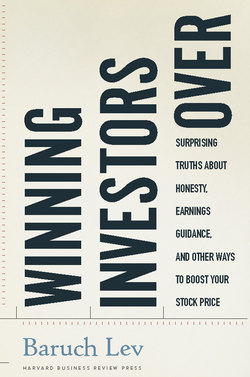Читать книгу Winning Investors Over - Baruch Lev - Страница 18
На сайте Литреса книга снята с продажи.
Surprise, Investors Are Human After All
ОглавлениеMainstream economists and finance scholars implicitly assume that investors, at least those that rely on information in making decisions, possess a perfect capacity to collect and process that information. They expeditiously read and digest the voluminous quarterly and annual financial reports of companies (including the generally indecipherable notes); attend conference calls and press meetings; read the various SEC filings of companies; learn about new technologies, innovations, and changes in the competitive environment of firms from governmental, research, and consultants' reports; speak with customers and suppliers; and do all this and more on a regular basis for fifteen to twenty companies typically followed by financial analysts and active investors. If investors were indeed able to achieve this physical and intellectual phenomenal feat, how could one explain the following research findings:
On Sunday, May 3, 1998, a New York Times front-page article about a promising drug developed by EntreMed, a biotech company, catapulted its stock price from $12 to $52, despite the fact that “the new-news content of the Times story was nil.”5 The attributes and prospects of this drug were thoroughly analyzed months earlier in scientific journals, and covered by the popular media, including the New York Times, though not on its front page. If investors process information fully and in a timely manner, the New York Times article, which didn't contain any new scientific or commercial information, should have been stale news, exerting no effect on EntreMed's stock price. And yet, the stock price more than quadrupled.
Research shows that pro forma (non-GAAP) earnings prominently displayed in the title or the first paragraph of a company's news release have a substantially stronger impact on stock prices than pro forma earnings reported less prominently in earnings releases.6 However, efficient information processors react only to the content of a message and are indifferent to the order of information release, or where it is placed in the message. And yet …
During the 1990s, managers of high-tech companies fought tooth and nail against the FASB's proposal to expense the value of employee stock options—namely, subtract it from earnings—yet were indifferent to reporting the same information in a footnote to the financial report. Evidently, managers believe that an item affecting net income will draw investors' attention, whereas they will largely ignore the same item disclosed in a footnote a few pages later in the report. But, surely, astute investors read financial report footnotes carefully and can easily subtract the value of stock options reported in a footnote from earnings.7 Managers clearly beg to differ.
A textual analysis of managers' narrative in earnings press releases indicates that the narrative's tone—level of optimism or pessimism—has a significant effect on investors' (price) reaction to the earnings release, beyond the quantitative, hard component of the message.8 Shouldn't hardened, rational investors be indifferent to the tone of a message, focusing only on its substance?
Last, companies tend to release poor earnings news on Fridays because the stock price reaction to Friday's news is significantly more muted than on Monday through Thursday. Indeed, studies have shown that there is a catch-up (delayed) stock price reaction to earnings announcements on Friday, occurring over several weeks.9 It's hard to believe that sophisticated, alert investors are distracted on Fridays by the approaching weekend; isn't fund management 24/7? And yet …10
Surprise, surprise: investors are evidently not the bloodless, efficient automatons populating economic and finance textbooks. They obviously suffer from what behavioral researchers call “limited attention,” namely, a seriously restricted ability to process and analyze the vast amount of information relevant to companies' values. In the Nobel Laureate economist Herbert Simon's words, “the scarce resource is not information, it is processing capacity to attend to information.”11 That's why investors focus on salient cues, information items that stand out in the crowded data mess, such as a front-page New York Times article about a promising drug, devoid of new information, or react strongly to pro forma earnings and restatements flashed in the heading of a news release, while reacting with reserve to similar information buried in the text of the release. Limited attention also implies that investors will use an information item as displayed to them, rather than engage in an extensive modification of the information,12 corroborating managers' belief that when the stock options expense is in the P&L report (displayed information), it will have a substantially stronger impact on investors than a footnote disclosure requiring investors to modify reported earnings.13 These are all important lessons for executives striving to communicate effectively to investors.
A more subtle yet equally serious manifestation of investors' limited attention and constrained information-processing capacity is their frequent failure to draw inferences from the absence of information, such as when a company that used to provide quarterly earnings guidance to investors stops doing so, often because of deteriorating performance.14 Similarly, investors rarely realize in time that some widely touted drugs while under development never made it to the market because the developers kept mum about the failure of these drugs in clinical tests.15 It's the same with companies that announce with fanfare plans for large stock repurchases (usually triggering stock price increases), yet never fulfill the promise. However, since the absent information was apparent (earnings guidance that was subsequently stopped), efficient information processors are expected to notice the change. They don't.
I dwell on the severe information-processing constraints and limited attention of investors because a comprehensive understanding of these limitations is central for designing effective capital-market communications policies. The tone (sentiment) of a message, where it is placed in a news release, when to keep mum, or what works in a conference call are essential components of an effective disclosure strategy to investors with limited attention, as I show next.16
